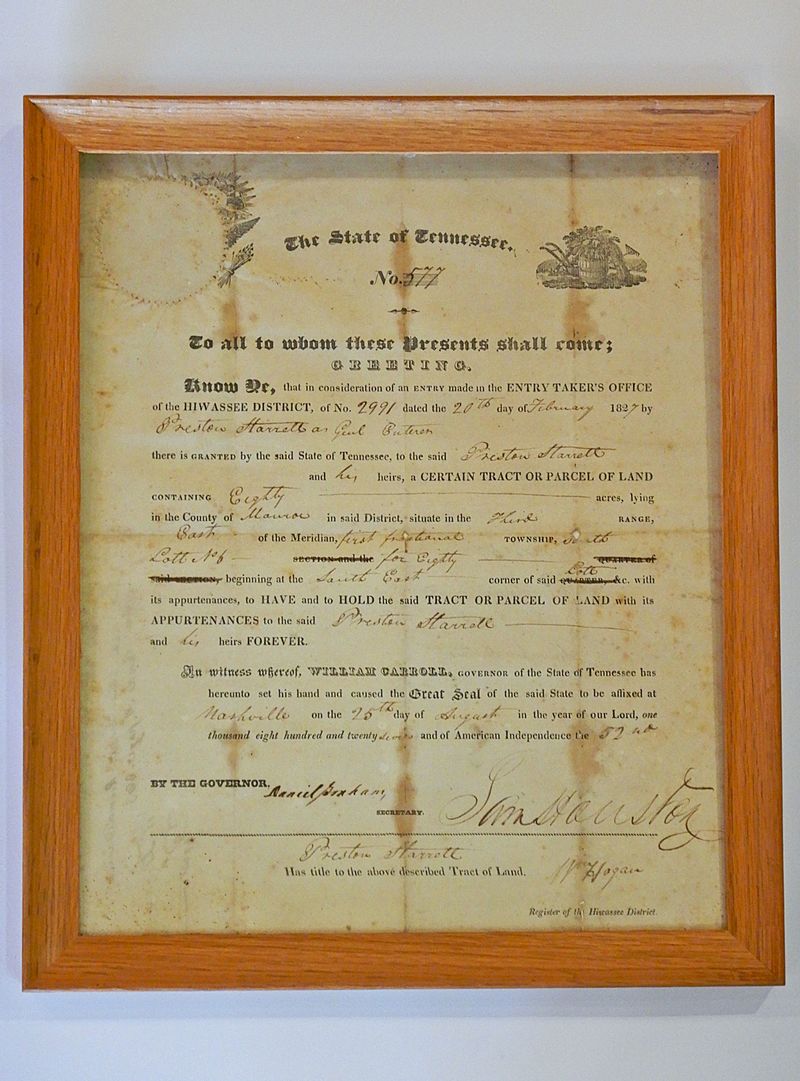The Hiwassee District & Early Settlers of Monroe County
Last Updated 7/1/2024
By Jubilee P. Reid

On February 27th, 1819, a treaty was signed between United States Secretary of War and later vice president, John C. Calhoun (1782 – 1850), and a group of Cherokee leaders. The Cherokee delegation included Chief John Ross, Lewis Ross, John “Chief Jack” Walker Jr., a descendant of Nancy Ward and other prominent Cherokees. Among the witness signers was Return Jonathan Meigs, a Cherokee agent.
This treaty designated the large amount of land between the Tennessee, Little Tennessee and Hiwassee Rivers as belonging to the United States government. The Cherokee leaders did not want to cede their tribal lands to the federal government, but they had no option as they were already being pushed off their lands. After the treaty was signed, the Cherokees were forced to move to other states to make way for white settlers. This was one of the many treaties that led to the Trail of Tears in which the U. S. government forcefully “purchased” Cherokee lands and relocated the native inhabitants.
Four days before the signing, President James Monroe authorized Calhoun to sign this treaty as a representative of the U. S. government. The “Calhoun Treaty,” as this land cession agreement is often called, was confirmed by the Senate on March 19th, 1819. At times this treaty has been referred to as the “Treaty with the Cherokee, 1819” or the “Ratified Indian Treaty #106.” This area of land was then known as the Hiwassee District.
The Hiwassee District was under the jurisdiction of the Register of East Tennessee and did not have its own land registrar until William Hogan took office in 1825. Hogan’s office was in the newly formed town of Athens, and he held the position until resigning in March of 1834.
McMinn and Monroe Counties, both established in November of 1819, were part of the Hiwassee District. The State of Tennessee issued land grants to people willing to settle the land in these and other counties. One such land grant is displayed in the McMinn County Living Heritage Museum.
This piece of paper, dated February 20th, 1827, bears the signatures of multiple people significant to the history of East Tennessee: Sam Houston (1793 – 1863), Tennessee Governor William Carroll (1788 – 1844), Tennessee Secretary of State Daniel Graham (1789 – 1869), and Register of the Hiwassee District William Hogan.
The grant is written to Preston C. Starrett (1790 – 1870), son of Revolutionary War soldier, James Starrett. This document granted 80 acres of land in Monroe County to “Preston Starrett and his heirs forever.” Numbered as grant No. 577, it contains lot numbers and other details as to the exact location of the specified acreage.
This grant was stamped with the Great Seal of the State of Tennessee in Nashville on August 25th, 1827. At this date, Sam Houston was the governor elect of Tennessee although he did not take office until October. He resigned less than two years later, leaving Tennessee.
William Carroll is still Tennessee’s longest serving governor having served six terms though not consecutively. Daniel Graham was the first Comptroller of the Treasury of Tennessee.
This 11.5 by 14-inch document is printed with blank spaces left to fill in with handwriting. The ink used for the handwritten parts is brown while the printed words are black. Printed in the upper left corner is a design similar to the Great Seal of the United States though it is mostly covered by another seal. The upper right corner features an image of a plow, rake, and other farm implements. Fold lines are visible from years the document spent folded in eighths.
Preston Starrett was named after Colonel William Preston (1730 – 1783) beside whom his father fought at the Battle of Guilford Courthouse. Preston married in 1811 and again in 1839, to a woman of Cherokee descent, after the death of his first wife. He lived in South Carolina before moving to Monroe County in 1819, eight years before he received the land grant. Twelve of his fifteen children were born in Monroe County near Tellico Plains. Descendants of the Starrett family still live in Monroe County; Starrett Street in Sweetwater was likely named after a family member. As was common before standardized spelling, multiple spellings of the Starrett family’s name were used including “Starritt” and “Sterritt.”
Preston’s father also lived on land taken from the Cherokee. He won land in Habersham County, Georgia in the 1820 Cherokee and Creek land lottery and lived there until his death in 1849.
This 197-year-old land grant was donated to the museum by Mr. & Mrs. S. B. Boyer in 1982, soon after the museum was founded. It is an important artifact documenting the history of the settlement of Monroe County.

